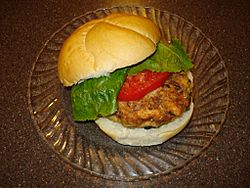Bulkie roll facts for kids

Spicy salmon burger on a bulkie
|
|
| Alternative names | Bulkie |
|---|---|
| Type | Bread roll |
| Place of origin | |
| Region or state | |
A bulkie roll (or just bulkie) is a special kind of sandwich roll. It is mostly found in New England, a region in the northeastern United States. You'll often find sandwiches made with bulkie rolls in local delis, restaurants, and school cafeterias.
Bulkie rolls are usually bigger and firmer than regular hamburger buns. Their outside crust is often a little bit crispy or crunchy. However, they are not hard rolls. The bread inside is like plain white bread. It is not too chewy or too fluffy. It also does not have a yellow color or taste like eggs. Bulkie rolls are usually not very sweet. You can find them plain or sometimes topped with poppy seeds.
Some people think bulkie rolls are the same as kaiser rolls. They are similar, but kaiser rolls are usually sweeter. Kaiser rolls are also often topped with poppy seeds.
History of Bulkie Rolls
Bulkie rolls have been a part of New England food for a long time. For example, before World War II, there was a Jewish grocery store in Manchester, New Hampshire. People remembered its owner for selling "hefty corned-beef sandwiches on bulkie rolls." This shows how popular these rolls were even back then.
What Does "Bulkie" Mean?
The word "bulkie" likely comes from the Yiddish language. In Yiddish, "bulke" or "bilke" means a small roll. These rolls were traditionally made with fine wheat flour and eggs.
Yiddish is a language that was spoken by many Jewish people, especially in Eastern Europe. The word "bulke" might come from the Polish word "bułka," which also means "roll." Before a terrible event called the Holocaust, there was a very large Jewish community in Poland. Because of this, about 15% of Yiddish words come from Slavic languages, like Polish.

